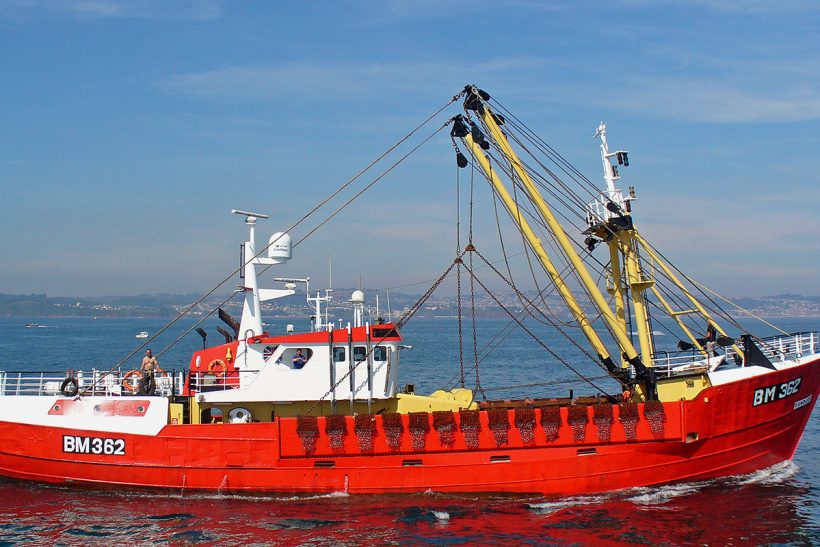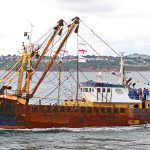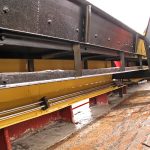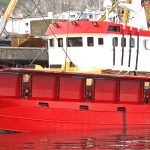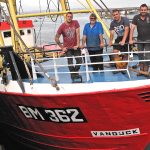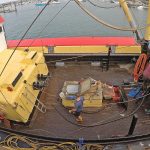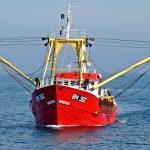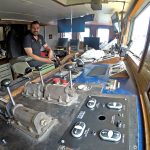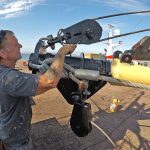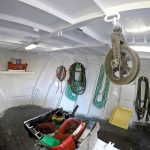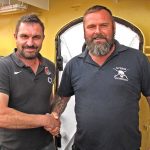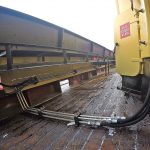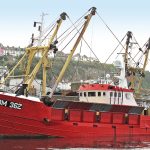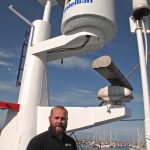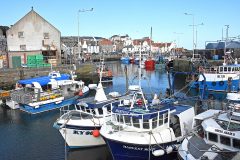Brixham scalloper van Dijck’s refit has come after a tough few years for skipper and owner Drew McLeod, and is the culmination of a couple of years of hard work that have brought the boat back from the brink, as anyone who watched the Channel 4 series The Catch will have been aware of, reports Quentin Bates.
Above: The new look van Dijck. (Photo: John Parham)
We had wanted a refit for a few years, but when times were hard, there wasn’t the money to throw at the boat. But you have to spend money on maintenance. You can’t expect it to work without upkeep – boats tend not to like that,” he said, speaking to Fishing News as van Dijck’s nine-week refit was coming to an end.
Things went badly wrong a few years ago, when the UK was found to have overshot its Area VII scallop days, and the days at sea were slashed, to the point that boats like van Dijck, which had been able to work practically as much as they were able, were down to 11 days a month – which is never going to be enough to keep a boat like this profitable.
Drew McLeod admits that the TV series caught them at their most vulnerable, as the bills had piled up, the cards and overdraft had been maxed-out, and he was struggling to keep van Dijck at sea and earning a living. With its track record almost entirely in scallops, there was no option of switching to beaming, apart from to make the most of non-quota species such as cuttlefish during the season.
He went back to taking the boat himself, including spending some time fishing elsewhere to keep the boat active while its precious Area VII days were so short. But working away from home was never an ideal situation, and for a couple of years, he and van Dijck struggled through, until a lifeline appeared in the form of an agreement with France to transfer some of their excess days to the UK.
“We struggled for a while on 11 days a month,” he said.
“But we soldiered on, and got some days back. We’re on 75 days for this quarter.
“The extra days were a lifeline after a couple of years of 32 to 36 days each quarter. The additional days gave us the opportunity to be profitable again – and to give the boat a much-needed refit. The days have increased gradually, first to 45-50 days each quarter and then in the region of 60 days, and we have 75 this quarter. The bank is also a lot happier with us now,” he added.
“The bank manager tried to push us towards going into administration, which was annoying as the value was always there in the boat itself. Now that we have days again, they were happy to give us a loan to carry out the refit, and even offered to sponsor us to buy another boat, yet they didn’t want to lend us money to keep the business going when we needed it.”
For the first time in years, van Dijck has the luxury of not using its days, as, with a nine-week refit, none of this quarter’s days had been used – and they cannot be carried over.
“You use them or lose them. So we have a month to do 75 days,” he said, adding that with good cuttle prices at the moment, it’s also tempting to do a scallop trip to make sure the new deck equipment is in working order, before putting on beam gear to make the most of the cuttlefish while they are there.
“How much cuttle bashing we do depends on how well the cuttle come through. We had less cuttle last year than the year before, but made more money on them. Switching to beaming for cuttlefish is worth doing in the winter, as beams will fish in worse weather. In bad weather, the scallop gear stops fishing, and it’s not worth it financially when you’re down to one or two bags a tow. It’s also more dangerous for the crew getting the gear in and out, so when the weather’s poor it’s worth switching to cuttles,” he said.
Scallops and cuttlefish are landed to FalFish, who have been van Dijck’s regular partners for many years, and any fish go to the Brixham auction.
“We’re allowed a 5% by-catch, which is turbot and brill, plus the occasional sole and monk. But we end up throwing away a lot of cuttlefish,’ he said, commenting that at one time cuttles were classed as a shellfish and could be retained, but some years ago they were re-classified as a cephalopod and became subject to the by-catch regulations, even though this is a non-quota species.
“So now we discard a lot of cuttlefish if they’re caught in scallop gear as they’re classed as by-catch, but if we target them and catch them in a trawl, then we can keep them. Go figure… It would make a big difference if we could keep them when we’re scalloping,” Drew McLeod said.
He said that van Dijck was built at the de Graeve yard in Zeebrugge in 1974, and came to McLeod Trawlers in September 1990, after it had already had 16 years of use as a beam trawler by its original Belgian owners.
“We did some beam trawling here and there, to begin with, but scallops have been our bread and butter. Scalloping, we’ll be sticking to the south-west, with a look at the eastern Channel when it opens on 1 October, and then there’s the Seine Bay that opens on 1 November.”
He commented that the agreement with the French on the additional days at sea for UK scallopers took a while to negotiate, and is part of a wider agreement that includes an area off northern Brittany closed to netting for part of the year, and is renegotiated annually.
“The French would still like to see the under-15m scallopers stopped, but the Western Waters agreements apply to vessels over 15m, and we have to tell the French that we can’t stop them. All we can do is ask the under-15s to respect the agreement. We understand their position, as their scalloping closes down from 15 May to 1 October every year, and they don’t want to see fishing on patches of scallops they have been saving for the best time of the year.
“We’re friendly with the French fishermen, and work with the French netting boats. We stay clear of their gear, and they’ll move their gear if there’s an area we want to get to. We’re all fishermen, and I don’t want to be messing up someone else’s living.”
New colour, new deck gear
After nine weeks tied up in Brixham, van Dijck is back at sea with a new colour scheme and a new set of tipping doors to make scalloping quicker and safer.
Drew McLeod said, “What saved us was that the boat had always been kept in good order, with a new engine six years ago and a new winch fitted at Luyt the year before that, so we were able to get through three or four years with minimal maintenance.”
In addition to everything else that has been done in its nine weeks alongside, van Dijck is sailing in new colours, and is now in red and white after years of being navy blue.
“It was either British racing green, or red. We went for red, and Alan Drysdale has been our chief painter through the refit.”
The whaleback has been shotblasted and painted, the fishroom has been boarded out and fitted out for scallops to be kept in 200-litre bins instead of sacks, which is expected to make landing quicker and easier – although Drew McLeod expects that some of the catch will still be bagged – and much of the engine room pipework has been replaced with stainless steel.
The big change to van Dijck – and the main reason the refit took nine weeks – are the new tipping doors, which replace the old tipping poles.
“We’ll be quicker to haul and shoot the gear, and there’ll be less interaction between the crew and gear, which makes things safer,” Drew McLeod said. “No more clipping in Gilsons and hauling the gear tight before emptying the dredges.”
Instead of upending the dredges using tipping poles, the 14-a-side gear is swung in each side against the doors, which then lift to tip the dredges out onto the conveyors running under each gunwale. As the doors lift, a chain skirt on each dredge lies over the teeth on the outer edge of each tipping door, keeping them securely in place.
Once van Dijck was alongside in Brixham, the work of cutting out the existing gear began, with a week’s preparation before the prefabricated new doors could be fitted.
“We chopped the rails and the conveyors off, and cut the sides out down to deck level,” Jason Stride explained.
“We saw Drew was getting nervous, until we brought the new gear down and lifted it all on board – and an hour-and-a-half later, there was a new set of rails and doors.”
Fabricated and fitted by Stride Engineering, the doors are the latest version of the tipping doors they have supplied to many of the Brixham beamer/scallopers, but this time built without using box section.
The doors are made in heavier steel along the bottom rail, and the size of the top rail has been increased. Weight is not a problem, and the amount of metalwork removed, including the no longer required lifting poles, is practically equal to the weight of the marginally heavier new deck gear.
“We already have orders for a couple more of these,’ Jason Stride said, adding that he had been waiting for an opportunity to work on this kind of gear on a boat where stability would not be a concern.
van Dijck’s new doors are extremely robust, and include 80mm bright mild steel hinges.
“They’re not going to wear out,” he said, commenting that this arrangement can be scaled back and made lighter for smaller beamers by using thinner steel plate.
As well as the complete new 14m sections installed in each of van Dijck’s gunwales, new conveyors with the belts contained inside the frame instead of hanging down have been fitted, with both doors and conveyors running off the boat’s existing hydraulic power pack. The doors are raised and lowered by the three compact hydraulic rams each side, which were fitted by Hercules Hydraulics.
“They also did all of the plumbing into the hydraulic system,” Drew McLeod said. “We weren’t sure if it would be enough, but it turned out that it is, and now the doors lift and drop back at the touch of a button.”
The refit brought in a number of local suppliers, notably Stride Engineering which designed, fabricated and fitted the new tipping doors.
This isn’t the first time that Jason Stride and his team have remodelled van Dijck’s gear-handling layout. Ten years ago, when the switch was made from the old-fashioned method of upending each of the 14-a-side dredges one at a time with a Gilson, to the faster tipping poles, it was Stride Engineering that did the work. Then, the rails were straightened to allow the tipping poles to do their job, but now the technology has moved on, and tipping doors are both faster and significantly safer for the crew.
“There’s no more clipping in Gilsons and pulling tight, no more pulling Gilsons down, no need to stand on the gear. The teeth keep the gear in place as it’s emptied, and it can’t go anywhere or fall on anyone. It’s a lot safer, and there’s less strain on the boat. We’re looking at seven or eight minutes of fiddling about on deck that we won’t be doing any more – and that adds up,” Drew McLeod said.
Depending on the fishing grounds, van Dijck takes anything between 12 and 24 tows in 24 hours.
“When we were fishing alongside boats that have tipping doors, we saw that they got in three or four more tows a day than we could,” he said.
“I wanted to do the refit in Brixham and keep the work local. I’d rather have it done here, where I can see it for myself, and keep the work and the money here in the port,” Drew McLeod said.
Hercules Hydraulics supplied the hydraulic rams and plumbed into the boat’s existing hydraulics, while Champion Engineering also did much of the welding on board during the refit, as well as refurbishing the roller blocks and the guiding-on rollers.
“Bobby Cann and his team of chippies, working under Ian Hunter, replaced half of the decking, stripping it back to the steelwork, and they also caulked the whole deck,” he said.
“The whole refit is about making fishing safer and more comfortable, and we were able to get an EMFF grant for the doors and conveyors, but, oddly, not for the two new pulling-down winches. There are no grants for winches, even though we tried to explain that this is part of the system for handling the gear, not for fishing.”
Globe Marine fitted van Dijck with an Intellian V-60 KA-band V-sat system, providing internet at sea.
“The crew had been badgering me for that for a while,” Drew McLeod said.
“It’s the newest and best for this size of boats, and we see more boats going for this now that airtime is down to a reasonable price,” Globe Marine engineer Ben Winfield said, adding that there are purchase and hire options available for this kind of system.
“There are two wifi points, one in the galley and one in the wheelhouse, and that gives the crew access to Facebook, internet, and phone so they can stay in touch while they are at sea, as well as up-to-date weather reports.”
He said that the boat’s E-Catch laptop also runs through the Intellian broadband system, providing a more secure connection and doing away with reliance on old technology.
Read more feature from Fishing News here.



